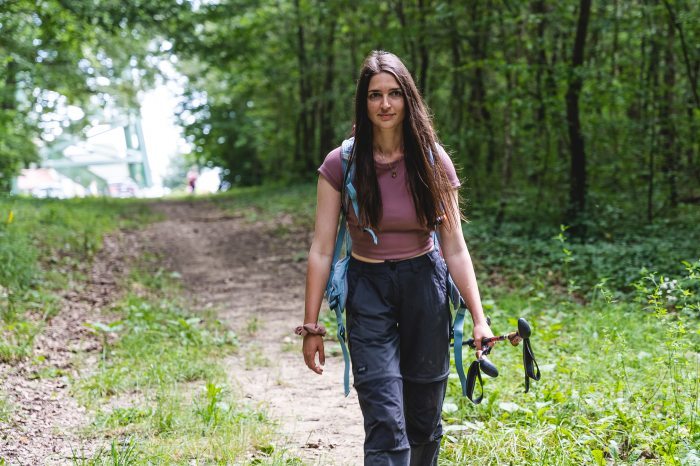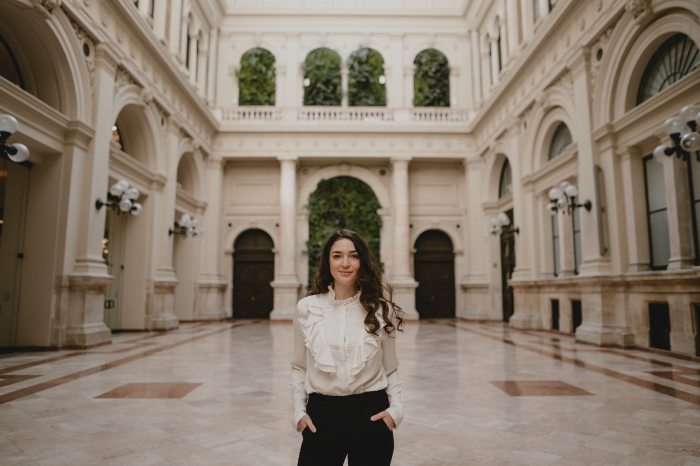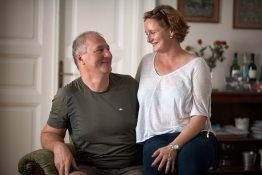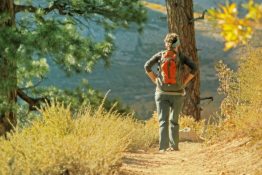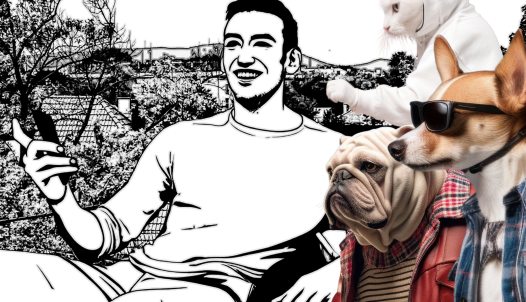A young woman hiked the country around solo – “It made me realize what a diverse place Hungary is”
2550 kilometers. That’s how long the National Blue Circle is. Anilla Till completed it all in 72 days. Alone. "I would prescribe it to everyone, we can learn a lot about ourselves, our physical condition, but especially our mind," she says. A documentary about her extraordinary achievement, entitled 2550, was released in Budapest cinemas on 23 May 2024. We talked to the 29-year-old doctoral student about her achievement, as well as the health of our planet, poor villages in east Hungary, and worn-out boots.
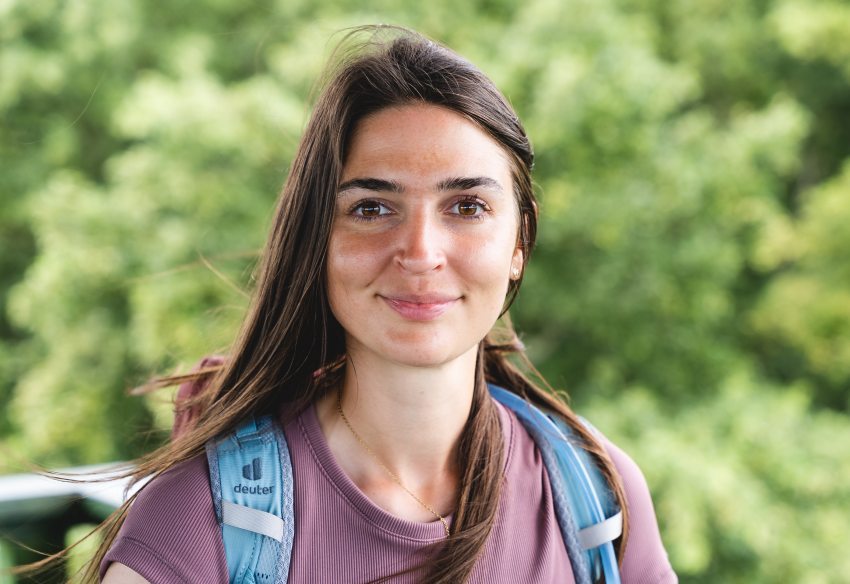
You've come home from Iceland for a few days. What are you doing out there?
I'm on a research exchange until July, as part of my doctoral studies in Budapest. I'm working on sustainability communication, trying to map how organizations and companies communicate to get people to change their behaviour and live more environmentally conscious.
Anilla Till, 29, a PhD student at Corvinus University, holds a Master's degree from Jönköping University in Sweden but has also studied in Helsinki and Paris. She currently lives in Iceland and works as a project manager in a Hungarian agency.
But I understand when people think that they cannot do anything about climate change on their own. It's easier to understand when we talk about the health of the planet: clean air, clean water, and green plants. People are more willing to change their behaviour to achieve this. While if we say to keep warming below one and a half degrees, the average person looks at you and says 'OK, but what does that mean?' What should I do? When we're out in nature and we smell the fragrances, see the colours, and hear the birds chirping, we really get a sense of why it's worth protecting our planet. Well, that's eye-opening.
Your return home is no coincidence, as a documentary called 2550 was made about you, as last summer you completed the 2550-kilometre National Blue Circle in 72 days. What is the difference between the Blue Trail and the Blue Circle?
One is a part of the other. The National Blue Circle consists of three trails: the National Blue Trail, the Rockenbauer Pál South Transdanubian Blue Trail, and the Blue Trail on the Great Plain. If you combine them, they make up one circle, the Blue Circle that runs all around the whole country.
How did you become a hiker? I understand you didn't even like weekend hikes very much before.
My first long-distance hike was El Camino, the world's most famous pilgrimage in Spain. When I was 18, we went on a trip to Santiago de Compostela, the endpoint of the Camino. I really liked it and thought it would be fun to do it one day. Six years later, I did it starting from Paris.
I wanted to do something similar back in Hungary, so I first walked the Hungarian Pilgrim's Route, and then I realized that the Blue Circle was similar. I put it off for a few years, and then last May the time and the opportunity came.
Whose idea was it to turn the challenge into a documentary?
The whole was Ferenc Mándi's idea, the director, producer, and all-rounder of the film. We used to be in the same study group at university, and we are old friends. When he heard I was going hiking, he suggested we make a film out of it. I left on 19 May 2023 and arrived at the end of July. That's how much time I had because I was planning to go to a festival after that. (laughs) I had exactly 72 days between my last class at university and my first day at the festival.
What did your typical day look like?
I woke up around five in the morning. Early morning hiking is good because nature around you is still asleep. I usually hiked 35.5 kilometres a day, which may seem like a lot at first, but once you get used to it, you can manage. I always stopped for breakfast, sometimes had a soft drink at a pub, had lunch later, and met lots of interesting people. I arrived at the accommodation in the early evening, washed my clothes, did some home office work and went to bed early.
I'm sure many people wonder how safe it is to hike alone as a woman.
There were about five to ten nights that I spent camping, and many people warned me against sleeping out alone. But the first time I was so tired I didn't have the energy to be afraid, I fell asleep straight away. True, my family was worried, but they always knew where I was, I was available, except when there was no signal. The more time went by, the safer I felt.
I was drawn by the experience of spending more time outside in nature. It's a great physical and mental challenge, very strong team building with yourself.
I was curious to see whether I could do it and what kind of person I would be in the end.
And? What did you find?
I realised that in the future I would not want to sit in front of a screen as much as I do now. I can't change that at the moment, but later I would like to do a job that doesn't involve spending 9 am to 4 pm in front of a screen. It also made me realise what a great place Hungary is, how diverse it is, and how nice the people are. It was a great adventure! I would prescribe it to everyone, we can learn a lot about ourselves, our physical condition, but especially our mind. It's a great way to learn about yourself. But if someone goes hiking and feels bad, or doesn't feel good on their own, that can be a useful lesson too.
Who did you meet along the way?
I'll try to say something that's not in the film, to avoid spoilers. There was a time when I ran out of water and I rang people's doorbells to see if they could give me some. When I arrived in a small village, I was very often approached on the street. And in the pubs, the slightly drunk men would often say, well, they wouldn't walk that much for sure...
Since you mention water, let's talk about nutrition. You're a vegan, and you mention in the film, that there were times when you couldn't eat until the afternoon because you couldn't find a grocery store. How do you deal with a situation like that?
Obviously, I was hungry, and I kept a small portion of food for luck in my backpack, but I didn't want to eat it because it wasn't an emergency. After a while, I got into a routine of eating, I cooked and prepared very simple things.
I wouldn't say it was a balanced diet, but I had consciously eaten more before the hike because I figured I'd need it. I lost about seven kilos.
You had some rough moments along the way, but these are not shown in the film, you only told us about them afterwards. For example, when you sat in the woods and cried. Was it a conscious decision to keep your intimacy private?
No, there was no such goal. When there's a deep moment in the woods, I think it's very unrealistic to take out my GoPro from my bag to film myself crying. Anyway, the way the shoot was done was that the director came on shooting days, and I had a GoPro with me so that if I wanted to shoot something, I could. I shot mainly just stock footage.
I really missed my loved ones. We kept in touch online and by phone, but it's not the same as having a coffee together. It was not an option to get on the bus or train and meet up. True, once I spent the night in our family home in Pásztó.
What equipment did you take with you?
Tent, camp mattress, sleeping bag, a few changes of clothes. I used a hydration system: I filled a flat container with water, put it in the backpack, and drank through a hose. You can drink without taking off your backpack. I also took a tablet for work. I also had pepper spray, but I never had to use it.
At first I went with a bigger backpack, in which my tent fit, but after a few weeks I changed it to a smaller one, because I lost a lot of weight, so it was important to have a lighter bag. I used up two hiking boots, both of them were used, they lasted about two thousand kilometres each. So now I don't even have hiking boots.
The cost was about 10 thousand forints a day. I did not receive any financial sponsorship, but four companies and organisations supported me with equipment, hiking gear, media coverage, Blue Trail hiking products and accommodation.
Were there any parts of the country that were new discoveries for you?
Of course, I've completely bypassed the two endpoints of the National Blue Trail, the mountain peak of Írott-kő and the village of Hollóháza. I really liked the mountains of Zemplén and the Őrség region. Walking through the poor villages of Nyírség (Eastern Hungary), I often wondered how lucky I was. I was able to get away from work, I could save money to go hiking. Many people, especially in these villages, would surely not be able to make such a decision.
It's great that I completed the Blue Circle, but it's also a huge privilege.
I set off from Hármashatár hill in Budapest and that's where I arrived. When I finally got to Nagyszénás Peak and could see Budapest, that was wonderful.
Who would you like to set an example for?
On the one hand, the film is for people who are Blue Trail hikers or want to be Blue Trail hikers. I hope to inspire a lot of people to do it, and for those who have already done it, it will feel nostalgic. The other is a more general message. If you really want to achieve something, it's up to you, your commitment, to make it happen: a new job, a business, writing a book, whatever.
The documentary 2550 - Walking Around a Country was screened in all the Cinema City cinemas across the country on 23 May 2024. As the screenings in Budapest were sold out, it was also shown in the capital on 24 May.
Do you think this could be a good promotional film for Hungary?
This is an interesting question because I think it would be good if the Blue Trail and the Blue Circle were more accessible to foreigners. I once heard of a Canadian man who wanted to do the Blue Trail of the Great Plains but couldn't find any information about it. It would be nice if the booklets were also available in English.
Was it in the cards that you would not succeed in what you had planned?
I have never done such a long hike. I knew I could do three or four weeks, but I didn't know what would happen after that. As I kept going forward, I felt that the only way it would fail was if I had a health problem or had to stop for family reasons. It was more the logistics that were difficult: when I started, I still had a big doctoral exam to do, which I finally completed during the Blue Circle. After a day's hiking, I drove up to Pest in the evening with my best friend, took the exam in the morning and returned to the Blue in the afternoon.
Will there be another hike?
Yes, probably in Iceland. I would like to improve my ability to spend more time in the wilderness, even alone, in nomadic conditions.
You have a mountain pendant on your necklace. Was it with you on the Blue Circle?
Yes, I bought it at a design fair in Budapest, I really liked it, it's perfect for hiking.
